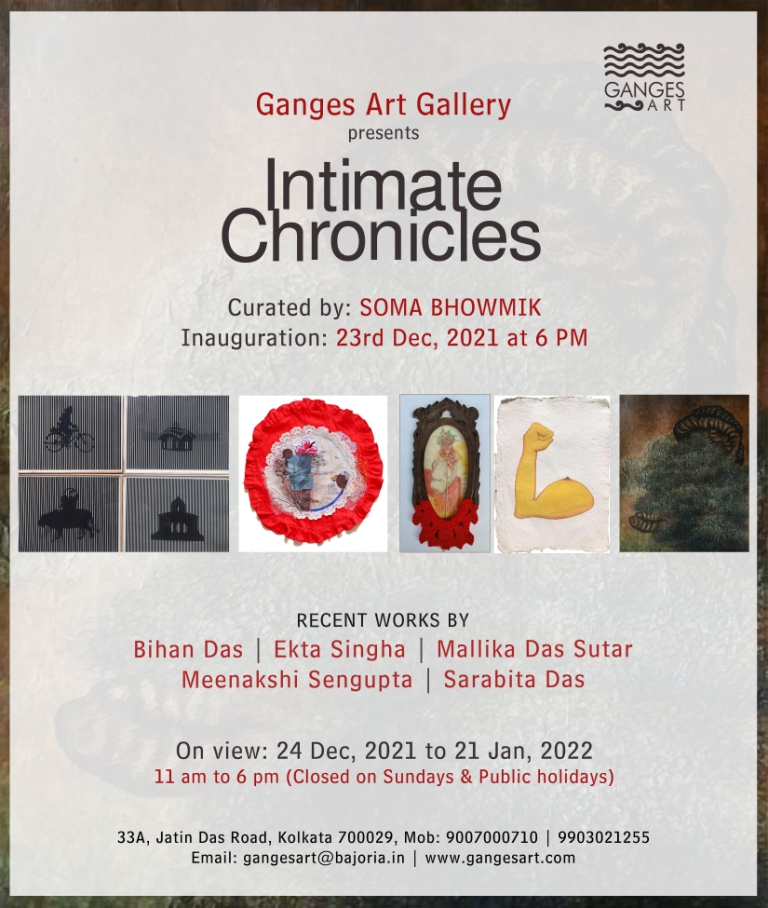
Our life is social and collective as much as it is personal and private. Artists often work in both the domains irrespective of the demarcating lines made by the societal norms and our habitual minds. On that same note, artists, more often than not make attempts at transcending the given boundaries and normative related to class, gender and private-public and to create larger spaces for expressions expecting the viewers to participate in many different ways and certainly with empathy and cerebral engagement.
The four artists showcased in this exhibition dissolve this distinction and many such discriminations and through these processes their works eventually become chronicles of their experiences of their lives in and out and their responses to the shifting domains. Their works do not tend to make any obvious statements but they take artistic and conceptual positions without any ambiguity. Their work differs from each other in terms of materials, conceptual frameworks and visual presentations but one can see a deep concern that connects all these works in a single show.
Bihan Das
Bihan Das is an artist from Kala Bhavana, Santiniketan. Born and brought up in Santiniketan, Bihan is intrigued by the land and landscape of Birbhum and the core concept that shapes his body of works is his desire to bring the narratives and lore of rural Birbhum district to the forefront. Having grown up in this landscape he feels a certain kinship with its history and stories of the "rarh" region, thus he tries his best to bring certain stories out with visual metaphors and juxtapositions from his personal attachment to the space. In this show the interactive work of Bihan evokes a yet uncharted essence of Birbhum land in a different form inviting an engagement from the viewers.
Ekta Singha
Ekta Singha in her recent series of works tries to narrate the left-over memories of her ancestors during the migration. In these works, she tries to emphasize the psychological impact of attachment and detachment with not only being live but also with a curtain place and object. In her woks she is developing an independent voice that makes its entrance in political surface layered with metaphorical and personal reference along with an emphasis on the role of love in relationship. Material is an important part of her work specially the using of stitches who signified both physical pain and after the execution the visual pleasure. The content and the use of different materials invoking her concept, memory, identity and intimate experiences.
Mallika Das Sutar
Mallika Das Sutar in her works addresses the marginalized people and their existences framed as ‘peripheral’, ‘abandonable’ and pushed away from the so-called ‘mainstreams’ in our society. Caught in the binaries of – ‘civilized-uncivilized’, ‘social-unsocial’, and ‘decent-indecent’, we too have learnt to, according to Mallika, to continually drive these people mentally and psychologically towards the borders of existence. While Mallika responds to the hypocritical stance of the so-called ‘educated’, she also represents and enfolds in her works, the marginal people enveloped with empathy. Eventually, Mallika pays her homage to the love these people embody and the people too.
Meenakshi Sengupta
Meenakshi Sengupta’s deliberate juxtapositions of ‘high’ art icons with those of mass culture hinged on wit and irony decodes the role of appropriated images as cultural signifiers. She plays with ‘signs’ as much as the reception of signs in the imagination of culture. Through Alice in Wonderland, she revisits the myth of a fantasy world whereas the drawings are focused on the gazes that are instrumental in inscribing such images in popular imagination. Her works thus provoke the onlookers to look back at the intimate accounts as well as at the circulation of the meanings caught in contradictions and paradoxes.
Sarabita Das
Sarabita Das in her works evokes the ideas of brutal stereotype masculinity, the prevailing power hegemony and the gendered parameters prevailing around. It’s the very question of existence as human being that is her central concern, stripping of every other imposed identity through her works. She tries to introspect human existence with the eyes of a non-revengeful member of the ‘softer-gender' though having frightening and dark autobiographical provocations and allusions. Her images are dense and often non-specific in representation yet powerful in terms of its organicity to evoke the unscripted thoughts and feelings.
Defining lines are required in life as well as in art. But they often tend to restrict the possible expansions of thoughts, ideas and creative imaginations. Contemporary art in general and many young artists are creatively and conceptually inclined to transgress these lines and accommodate socially relevant ideas, no matter what they might stimulate us to reimagine our future. The four artists, all in their own inimitable ways, embody this spirit and this propensity.